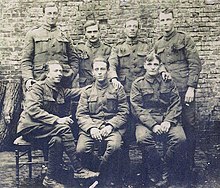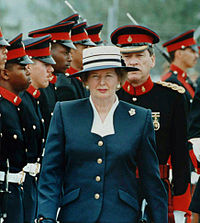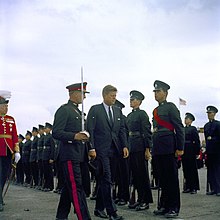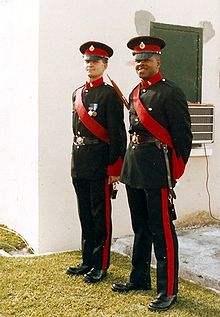Royal Bermuda Regiment
The two original units, the mostly black Bermuda Militia Artillery and the almost entirely white Bermuda Volunteer Rifle Corps, were raised 1895 and 1894, respectively, in accordance with two of three acts passed by the Bermudian parliament in 1892 at the insistence of the British Government, which had been attempting to encourage, entice, or coerce the local government to restore reserve military units since the last Militia Act had been allowed to lapse following the Napoleonic Wars and the American War of 1812.[3] Following the First World War, the British Government's policy of austerity resulted in a substantial reduction of the regular army, including reducing the regular infantry in Bermuda and removing the Royal Artillery and the Royal Engineers Fortress companies from Bermuda in 1928, with the local reserve units shouldering more responsibility.Those other ranks who chose to continue serving were re-attested, committing to terms of service which meant they could no longer quit the corps with fourteen days notice.The full badge, as displayed on the Colours, features two crossed cannons creating an X behind a Maltese cross (the symbol of rifle regiments in the British Army, and used on the white metal BVRC badge), set on a circular shield with "THE BERMUDA REGIMENT" inscribed around it, and the whole enclosed within a wreath and surmounted by the Crown.This is a result of the peculiar climate of Bermuda, which is chilly, wet, and windy during the winter, and can reach 30 °C (86 °F) during the summer with high humidity.At the time of amalgamation, the basic combat uniform worn under the Denison was composed of the Second World War-era green tropical shirt and trousers, ankle boots and puttees.The colour varies slightly from the standard British Army khaki (being greener), and during the summer months, the long trousers might be replaced with shorts.The Royal Bermuda Regiment service dress is composed of a jacket and trousers worn with an olive green peaked cap, tan shirt and tie.Following discipline problems during an exercise in the West Indies, a report on the unit was commissioned from Major-General Glyn Gilbert, the highest-ranking Bermudian in the British Army.Maj-Gen. Gilbert also took into account the difficulties the regiment had experienced in meeting its obligations when deployed during the civil unrest of 1977 (its existing strength did not allow for a reserve).As the support functions (Regimental Quartermaster Stores and Internal Security Stores, Signals, Armourers, Motor Transport, Boat Troop, Gun Troop/Assault Pioneers, Medics, cooks, et cetera) and the Band now fell under Support Company (commanded by the Regimental Quartermaster), the battalion headquarters was no longer considered a company in its own right.Temporary deferment was granted for full-time students (attending either the Bermuda College or schools abroad), for the length of their studies, and individuals medically unfit but likely to become fit again.Conscientious objectors had the opportunity to either serve in a non-combatant role or perform an alternative community service chosen by the governor.Both Bermudians and non-Bermudians criticised conscription for its alleged sexism and similarity to slavery (a sensitive issue given the historic background of Bermuda), and this has been noted in the British Parliament.Other roles include ceremonial duties, and supporting the Bermuda police department in internal security issues (both in the forms of riot-control and anti-terrorism).They worked alongside soldiers from Barbados, Guyana, India and South Africa, in ensuring a secure environment for the Super 8 series of matches.Although little has been made of this deployment, this was the first time since the First World War that a formed unit from Bermuda has deployed overseas for an operation other than disaster relief (the Second World War drafts from the BMA, BVRC, and BVE were all absorbed into other units, and the cadre of officers and NCOs sent to Belize in the 1980s were attached to a battalion of the Royal Anglians).The ship had been detained on the Atlantic by the United States Coast Guard carrying over a hundred illegal migrants with the intent of smuggling them into Massachusetts.Taking the ship into a US port to transfer the detainees to Cuba was undesirable as the US Government would have then been obliged to allow any who requested to enter the process for asylum application.When the UK Volunteer Force, Yeomanry, and Militia had been reorganised into the Territorial Force in 1908 (renamed the Territorial Army after the First World War), the many former Volunteer Rifle Corps became numbered battalions of British (Regular) Army regiments, with the regular regiments adopting paternal roles by providing the part-time units with loaned officers, warrant officers and NCOs, and taking other steps to give them the benefit of their experience.Throughout the Bermuda Regiment's history, the Royal Anglians have provided it with its staff officer, and with Permanent Staff Instructors (PSI) (now called full-time instructors (FTI)) warrant officers (WO2) for each of its companies, as well as other personnel on long-term and short-term attachments (although other Regiments have occasionally also provided personnel on loan).[19] The 2017 Corp Warrant notes that the competition of Corps composition 'The under mentioned bodies of the [British] Army comprising Regular Forces, Army Reserves, Regular Reserve, including any raised hereafter and any local units overseas: of which the Royal Bermuda Regiment was listed with the composition note; All units and personnel of The Royal Bermuda Regiment.[44][45] This was due to the cost of deploying to Jamaica (a flight of 1,249 miles, compared to 725 miles for the flight to MCAS Cherry Point, North Carolina), given the budgetary constraints, and as Jamaica provided little opportunity for training in Internal Security roles, such as is available at USMCB Camp Lejeune with its Military Operations in Urban Terrain (MOUT) facility.Specialist Bermuda Regiment sub-units, such as the Reconnaissance Platoon and the Medics, have trained with equivalent US Marine Corps units at Camp Lejeune.For Internal Security use, the Federal Riot Gun being used in Northern Ireland for firing baton rounds and gas canisters was also adopted.The Royal Small Arms Factory at Enfield Lock had actually begun work in 1969 on a family of weapons mechanically based on the ArmaLite AR-18, but chambered for a 4.85 × 49mm cartridge and with a bullpup configuration similar to the EM-2.The Bermuda Regiment decided not to wait for the SA80 and replaced the SLR with the American-made Ruger Mini-14 self-loading (in American parlance, "semi automatic") rifle in 1983.This was necessary as large numbers of personnel must attend courses (for training, commissioning, or qualification) in Britain, and many serve on active duty attachments (particularly with the Royal Anglian Regiment), and needed to already be knowledgeable of the standard rifle.






















BermudaLine InfantryBattalionWarwick CampColonel-in-ChiefBirgitte, Duchess of GloucesterBritish Overseas TerritoryterritorialinfantryBermuda Militia ArtilleryBermuda Volunteer Rifle CorpsBermuda GarrisonWestern FrontRemembrance DayCenotaphDesmond LangleyNapoleonic WarsAmerican War of 1812First World WarBermuda Volunteer EngineersBermuda Militia InfantrySt David's BatteryQueen's Own Cameron Highlanders1st Caribbean RegimentSecond World WarLincolnshire RegimentMargaret ThatcherRoyal Navy's dockyardRoyal NavyJohn F. KennedyRoyal ArtilleryBermuda RiflesPrincess MargaretDuchess of GloucesterChannel IslandsBritish Army order of precedenceRoyal Regiment of ArtilleryQueen Elizabeth IIMaltese crossstable beltRoyal Lincolnshire RegimentRoyal Anglian Regimentred tunicMulti-Terrain PatternDenison parachute smockJunior LeadersService DressMess dressLieutenant colonelCaptainLieutenantSergeantCorporalLance corporalPrivateUnited KingdomGovernorBritish Army Order of Battle as number 29th in order of precedencePrincess Margaret, Countess of SnowdonThe Duchess of GloucesterMajor-General Glyn GilbertBritish Army25-pdr. field gunsMini-14conscriptsBermuda CollegeConscientious objectorsnon-combatantBritish ParliamentHouse of Assembly of BermudaMinistry of Defencecommand and controlBermuda Cadet CorpsMini-14sSeptember 11 attacksBermuda International AirportCayman IslandsGrenadaHurricane IvanWCC Cricket World CupRoyal AngliansUnited States Coast GuardGuantanamo Bay Naval BaseNAS BermudaCastle HarbourC-130 HerculesUS NavyCamp LejeuneVolunteer ForceYeomanryMilitiaTerritorial ForcePermanent Staff InstructorsThe Lincoln and Welland RegimentCanadian ArmyRoyal Artillery AssociationRoyal Gibraltar RegimentCH-46 Sea KnightNorth CarolinaUnited StatesUnited States Marine CorpsUnited States NavyCamp GeigerAfghanistanFloridaFlorida National GuardJamaicaYork and Lancaster RegimentMCAS Cherry PointLand Force Central Area Training Centre MeafordMeafordOntarioJamaica Defence ForceUS Coast GuardAir-Sea RescueElizabeth CityMoroccoEnglandCinque PortsDefence Training EstateCayman RegimentThe Royal Anglian RegimentCanadaThe Jamaica Defence Forcemajorslieutenant-colonel